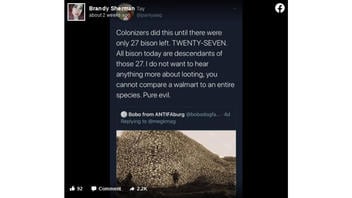
Did colonizers kill bison until there were only 27 left? No, that's not true: While it is true that North American Bison Herds were brought dangerously close to extinction due to a variety of factors, and this had a devastating impact on the people who depended on the bison for food, shelter and clothing, the population was never so small as only 27. The meme's creator apparently was making the point that recent looting in U.S. cities during protests is nothing compared to the European settlers plundering of America's bison herds.
The claim originated as a tweet and a screenshot was made into a facebook post (archived here) where it was published on August 31, 2020. The caption in the original Tweet read:
Colonizers did this until there were only 27 bison left. TWENTY-SEVEN. All bison today are descendants of those 27. I do not want to hear anything more about looting, you cannot compare a walmart to an entire species. Pure evil.
This is what the post looked like on Facebook at the time of writing:
(Source: Facebook screenshot taken on Mon Sep 14 18:20:29 2020 UTC)
The original tweet included a retweet of a photo(here)(archived here) that is dated about 1892, and is part of the Burton Historical Collection of the Detroit Public Library. The description reads, "Bison skulls await industrial processing at Michigan Carbon Works in Rogueville (a suburb of Detroit). Bones were used processed to be used for glue, fertilizer, dye/tint/ink, or were burned to create "bone char" which was an important component for sugar refining." A second photo of this same bone pile from a different angle can be viewed (here)(archived here).
 |
In 1889 William T. Hornaday, a zoologist and taxidermist who would become a conservationist as well, wrote an important report, "The Extermination of the American Bison" (here) At the time of writing, he held out little hope that bison would not be extinct in the wild within ten years. In the introduction he makes mention of the process that likely resulted in a bone pile such as this, at a time when the bison were already almost gone, "The wild buffalo is practically gone forever, and in a few more years, when the whitened bones of the last bleaching skeleton shall have been picked up and shipped East for commercial uses, nothing will remain of him save his old, well-worn trails along the water-courses, a few museum specimens, and regret for his fate." In Part II, section III, Chapter 5 he provides a chart with very exact numbers of isolated small wild herds, totaling 85 individuals in the US, and 550 in the Northwest Territory, for a total of 635.
In the next chapter he cites the number of people from 17 tribes counted in the 1886 census: 54,758, who depended on the bison. He presents the devastation facing the Native American people in the US as if it were simple economics:
The Indians of what was once the buffalo country are not starving and freezing, for the reason that the United States Government supplies them regularly with beef and blankets in lieu of buffalo. Does any one imagine that the Government could not have regulated the killing of buffaloes, and thus maintained the supply, for far less money than it now costs to feed and clothe those 54,758 Indians!
The report Hornaday shared from the Northwest Territory is especially grim and even mentioned the desperation of cannibalism.
During the winter of 1886-'87, destitution and actual starvation prevailed to an alarming extent among certain tribes of Indians in the Northwest Territory who once lived bountifully on the buffalo. A terrible tale of suffering in the Athabasca and Peace River country has recently (1888) come to the minister of the interior of the Canadian government, in the form of a petition signed by the bishop of that diocese, six clergymen and missionaries, and several justices of the peace. It sets forth that "owing to the destruction of game, the Indians, both last winter and last summer, have been in a state of starvation. They are now in a complete state of destitution, and are utterly unable to provide themselves with clothing, shelter, ammunition, or food for the coming winter."
While the author of the original post does not cite a source or a date for the number, it seems likely that the number 27 originated from the size of the free roaming herd in the area of Yellowstone. Lead Stories reached out to the chief wildlife biologist at Yellowstone National Park and they explained:
By 1900, there were about two dozen bison left in the Yellowstone area. Historians have indicated the near extirpation of bison in North America was primarily due to widespread slaughter by Euro-American colonists during the 1870s and 1880s. Other factors such as habitat degradation and destruction also likely contributed. There are several other lineages of bison in North America, so all contemporary bison are not descended from indigenous bison in the Yellowstone area.
This page introduces the importance of bison to Native American culture and survival, as well as the purposeful campaign in the 1800's to remove Native American people by removing their main food source. In Yellowstone, when the effort to protect and rebuild the bison herd began- additional animals from private ranches were introduced:
...By the late 1880s, the great herds of bison that once dominated the landscape were nearly gone. Some animals found protection on private ranches. In the Yellowstone area, their numbers dwindled to about two dozen bison left in Pelican Valley.
In one of the first efforts to preserve a wild species through protection and stewardship, Yellowstone's managers set about recovering the bison population. In 1902, they purchased 21 bison from private owners and raised them in Mammoth and then at the historic Lamar Buffalo Ranch. Eventually, these animals began to mix with the park's free-roaming population and by 1954, their numbers had grown to roughly 1,300 animals.
In the early 1870s, very large numbers of bison were slaughtered, mainly for hides, but also for meat and sport. Further, this slaughter had negative effects on Indians living in buffalo country and was not generally discouraged by government officials. By the middle 1880s, bison were nearly extinct. Plains bison were saved from extinction in the late 1800s by 5 private herds established by ranchers and by a sixth herd at the New York Zoological Park. Altogether, these herds were established with less than 100 wild-caught founders. In addition, a small remnant wild population survived in what is now Yellowstone National Park. This population declined to an official estimate of 25 animals in 1902 (Meagher 1973). In other words, nearly all the present-day plains bison in the United States are descended from a founder population of 100 or less, and probably an effective founder number substantially less than 100, because of the small sizes of the herds in the initial generations.
















